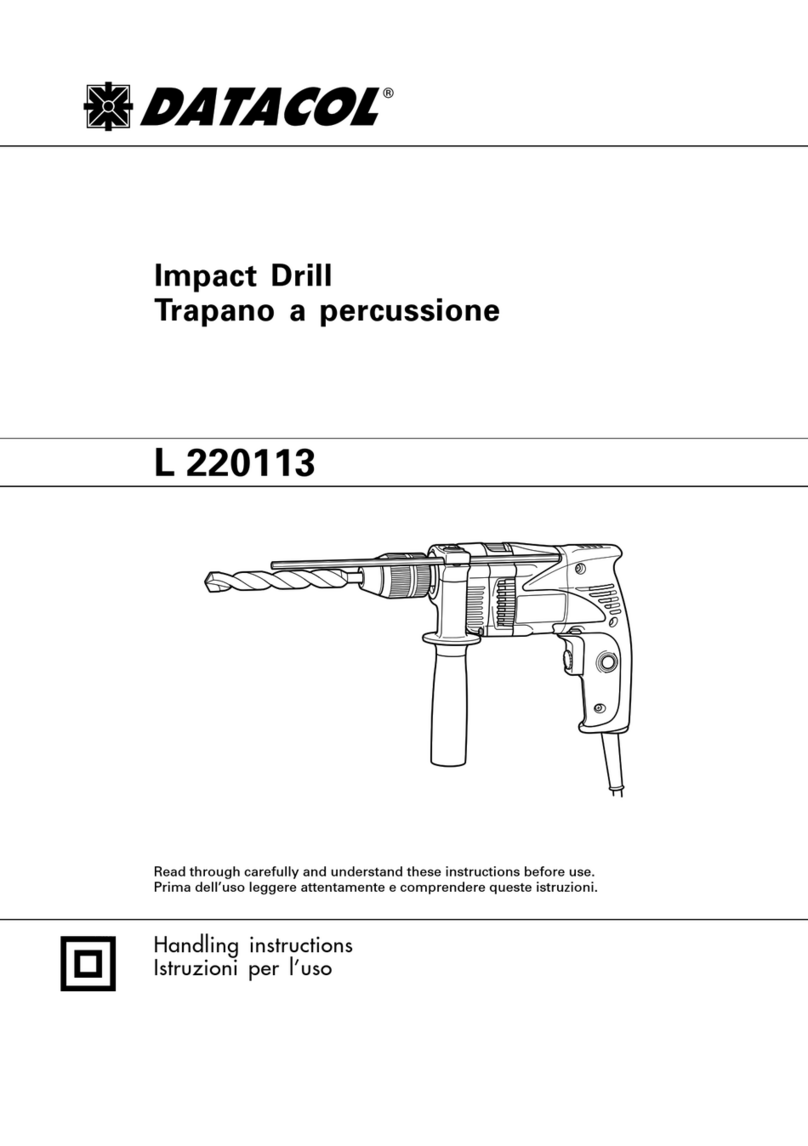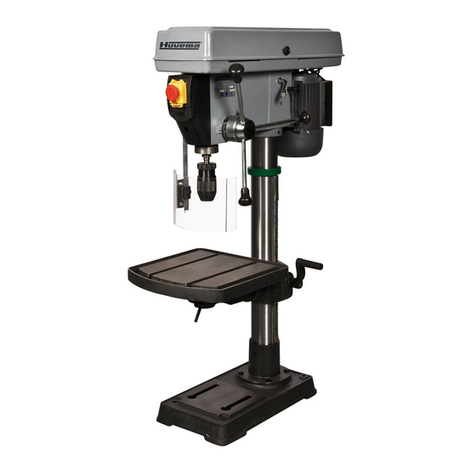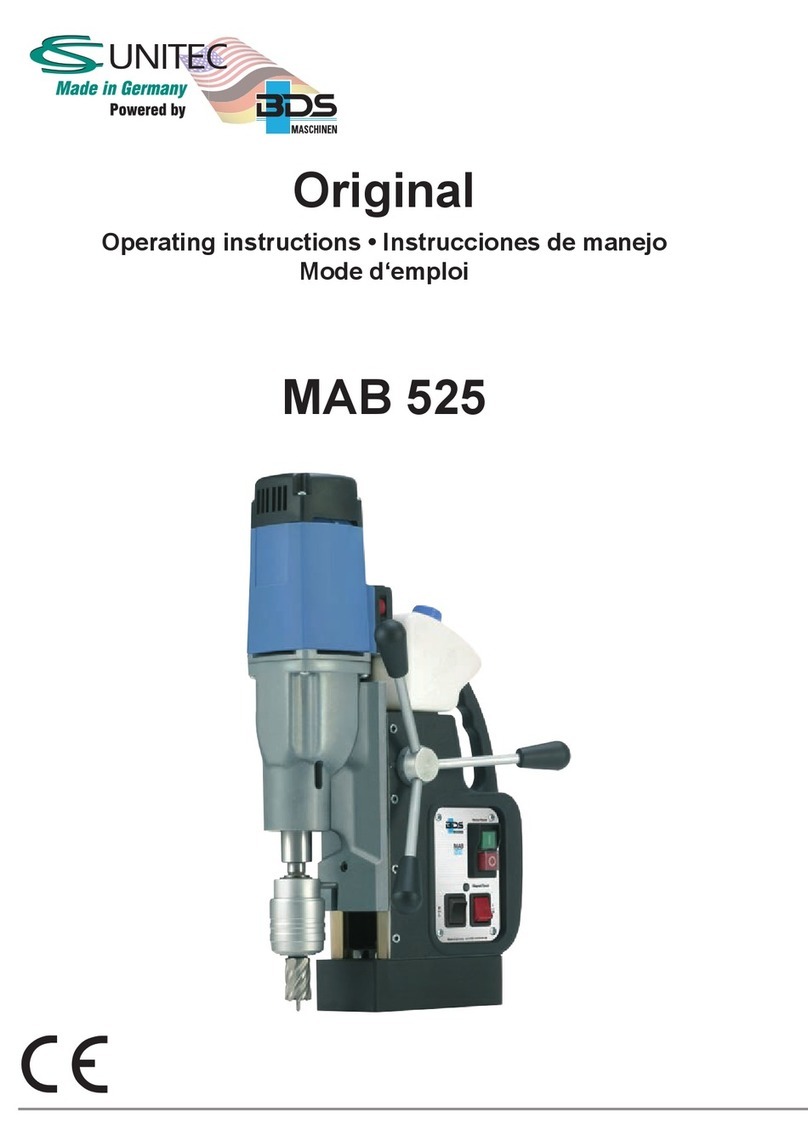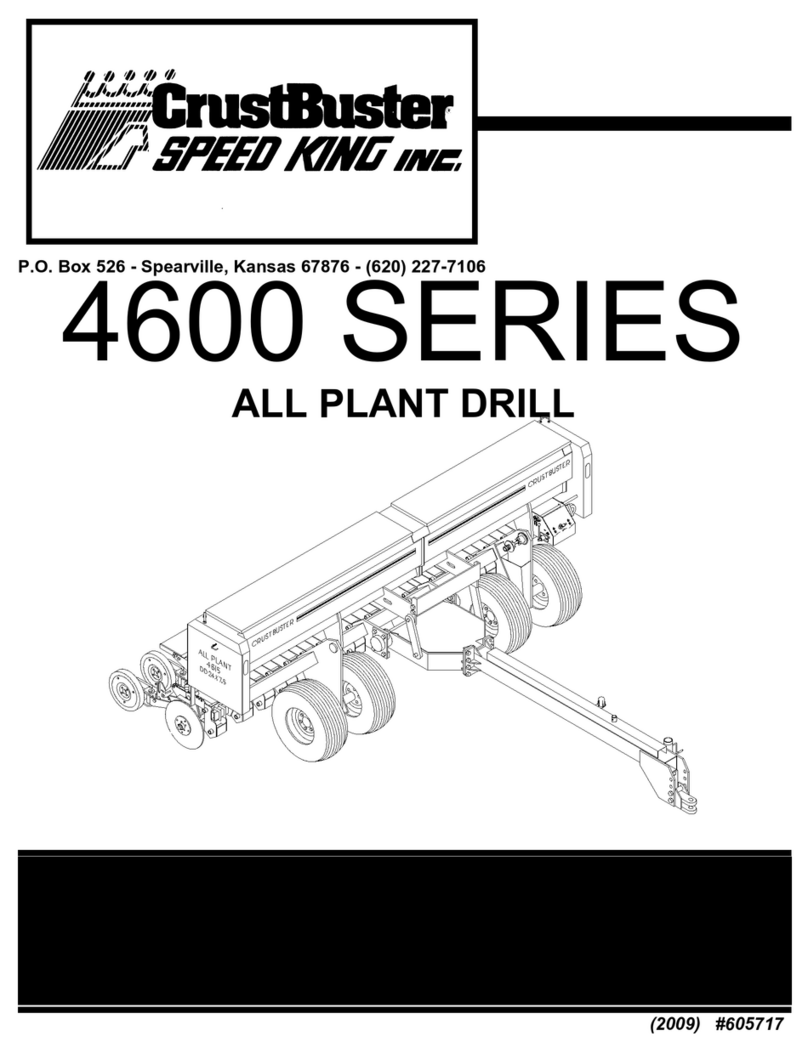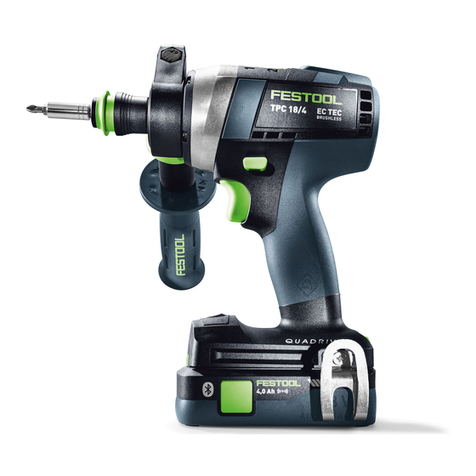Datacol L220114 User manual

Handling instructions
Istruzioni per l’uso
Impact Drill
Trapano a percussione
L220114
Read through carefully and understand these instructions before use.
Prima dell’uso leggere attentamente e comprendere queste istruzioni.
0000L220114.indb10000L220114.indb1 2018/03/2015:28:572018/03/2015:28:57

2
1
5
3
6
4
2
4
6
5
8
3
09
@
!
4
3
8
4
56
$
^%
4 3
#
5
7
&
8
)
q
9
*
(
0000L220114.indb20000L220114.indb2 2018/03/2015:28:582018/03/2015:28:58

3
9
English Italiano
1Drill chuck Mandrino trapano
2Chuck wrench Chiave mandrino
3Tighten Stringere
4Loosen Allentare
5Sleeve Collare
6Ring Anello
7Lock collar Collare di blocco
8Side handle Maniglia laterale
9Switch trigger Grilletto interruttore
0Push button Pulsante
!mark Segno
@mark Segno
#Depth gauge Calibro di profondità
$Change lever Leva di cambiamento
%Impact Impatto
^Rotation Rotazione
&Gear shift dial Regolazione di velocità
*Speed control dial Comando di velocità
(High speed Alta velocità
)Low speed Bassa velocità
qStopper Fermo
0000L220114.indb30000L220114.indb3 2018/03/2015:28:582018/03/2015:28:58

4
Symbols
WARNING
The following show
symbols used for the
machine. Be sure that
you understand their
meaning before use.
Simboli
AVVERTENZA
Di seguito mostriamo
i simboli usati per la
macchina. Assicurarsi
di comprenderne
il significato prima
dell’uso.
To reduce the risk of
injury, user must read
instruction manual.
Failure to follow
the warnings and
instructions may result
in electric shock, fire
and/or serious injury.
Per ridurre il rischio
di lesioni, l’utente
deve leggere il
manuale delle
istruzioni.
La mancata osservanza
degli avvertimenti e
delle istruzioni potrebbe
essere causa di scosse
elettriche, incendi e/o
gravi lesioni.
Only for EU countries
Do not dispose of
electric tools together
with household waste
material!
In observance of
European Directive
2002/96/EC on
waste electrical and
electronic equipment
and its implementation
in accordance with
national law, electric
tools that have reached
the end of their life
must be collected
separately and returned
to an environmentally
compatible recycling
facility.
Solo per Paesi UE
Non gettare le
apparecchiature
elettriche tra i rifiuti
domestici.
Secondo la Direttiva
Europea 2002/96/
CE sui rifiuti di
apparecchiature
elettriche ed
elettroniche e la
sua attuazione in
conformità alle
norme nazionali,
le apparecchiature
elettriche esauste
devono essere raccolte
separatamente, al fine
di essere reimpiegate in
modo eco-compatibile.
0000L220114.indb40000L220114.indb4 2018/03/2015:28:582018/03/2015:28:58

5
English
GENERAL POWER TOOL SAFETY WARNINGS
WARNING
Read all safety warnings and all instructions.
Failure to follow the warnings and instructions may result in
electric shock, fire and/or serious injury.
Save all warnings and instructions for future
reference.
The term “power tool” in the warnings refers to your mains-
operated (corded) power tool or battery-operated (cordless)
power tool.
1) Work area safety
a) Keep work area clean and well lit.
Cluttered or dark areas invite accidents.
b) Do not operate power tools in explosive
atmospheres, such as in the presence of
flammable liquids, gases or dust.
Power tools create sparks which may ignite the dust
or fumes.
c) Keep children and bystanders away while
operating a power tool.
Distractions can cause you to lose control.
2) Electrical safety
a) Power tool plugs must match the outlet.
Never modify the plug in any way.
Do not use any adapter plugs with earthed
(grounded) power tools.
Unmodified plugs and matching outlets will reduce
risk of electric shock.
b) Avoid body contact with earthed or grounded
surfaces, such as pipes, radiators, ranges and
refrigerators.
There is an increased risk of electric shock if your
body is earthed or grounded.
c) Do not expose power tools to rain or wet
conditions.
Water entering a power tool will increase the risk of
electric shock.
d) Do not abuse the cord. Never use the cord for
carrying, pulling or unplugging the power tool.
Keep cord away from heat, oil, sharp edges or
moving parts.
Damaged or entangled cords increase the risk of
electric shock.
e) When operating a power tool outdoors, use an
extension cord suitable for outdoor use.
Use of a cord suitable for outdoor use reduces the
risk of electric shock.
f) If operating a power tool in a damp location
is unavoidable, use a residual current device
(RCD) protected supply.
Use of an RCD reduces the risk of electric shock.
3) Personal safety
a) Stay alert, watch what you are doing and use
common sense when operating a power tool.
Do not use a power tool while you are tired
or under the influence of drugs, alcohol or
medication.
A moment of inattention while operating power tools
may result in serious personal injury.
b) Use personal protective equipment. Always
wear eye protection.
Protective equipment such as dust mask, non-skid
safety shoes, hard hat, or hearing protection used
for appropriate conditions will reduce personal
injuries.
c) Prevent unintentional starting. Ensure the
switch is in the offposition before connecting
to power source and/or battery pack, picking
up or carrying the tool.
Carrying power tools with your finger on the switch
or energising power tools that have the switch on
invites accidents.
d) Remove any adjusting key or wrench before
turning the power tool on.
A wrench or a key left attached to a rotating part of
the power tool may result in personal injury.
e) Do not overreach. Keep proper footing and
balance at all times.
This enables better control of the power tool in
unexpected situations.
f) Dress properly. Do not wear loose clothing or
jewellery. Keep your hair, clothing and gloves
away from moving parts.
Loose clothes, jewellery or long hair can be caught
in moving parts.
g) If devices are provided for the connection of
dust extraction and collection facilities, ensure
these are connected and properly used.
Use of dust collection can reduce dust-related
hazards.
4) Power tool use and care
a) Do not force the power tool. Use the correct
power tool for your application.
The correct power tool will do the job better and
safer at the rate for which it was designed.
b) Do not use the power tool if the switch does not
turn it on and off.
Any power tool that cannot be controlled with the
switch is dangerous and must be repaired.
c) Disconnect the plug from the power source
and/or the battery pack from the power tool
before making any adjustments, changing
accessories, or storing power tools.
Such preventive safety measures reduce the risk of
starting the power tool accidentally.
d) Store idle power tools out of the reach of
children and do not allow persons unfamiliar
with the power tool or these instructions to
operate the power tool.
Power tools are dangerous in the hands of untrained
users.
e) Maintain power tools. Check for misalignment
or binding of moving parts, breakage of parts
and any other condition that may affect the
power toolʼs operation.
If damaged, have the power tool repaired
before use.
Many accidents are caused by poorly maintained
power tools.
f) Keep cutting tools sharp and clean.
Properly maintained cutting tools with sharp cutting
edges are less likely to bind and are easier to
control.
g) Use the power tool, accessories and tool bits
etc. in accordance with these instructions,
taking into account the working conditions and
the work to be performed.
Use of the power tool for operations different from
those intended could result in a hazardous situation.
5) Service
a) Have your power tool serviced by a qualified
repair person using only identical replacement
parts.
This will ensure that the safety of the power tool is
maintained.
0000L220114.indb50000L220114.indb5 2018/03/2015:28:582018/03/2015:28:58

6
English
PRECAUTION
Keep children and infirm persons away.
When not in use, tools should be stored out of reach
of children and infirm persons.
IMPACT DRILL SAFETY WARNINGS
1. Wear ear protectors when impact drilling.
Exposure to noise can cause hearing loss.
2. Use auxiliary handle(s), if supplied with the tool.
Loss of control can cause personal injury.
3. Hold power tool by insulated gripping surfaces,
when performing an operation where the cutting
accessory may contact hidden wiring or its own
cord.
Cutting accessory contacting a “live” wire may make
exposed metal parts of the power tool “live” and could
give the operator an electric shock.
4. Before drilling into walls, ceilings or floors, ensure that
there are no concealed power cables inside.
5. Always use side handle and hold the tool firmly with
both hands.
6. Always use the impact drill with clockwise rotation,
when using it as an impact drill. (Fig. 9)
○When boring wood
Use an ordinary woodworking drill bit.
However, when drilling 6.5 mm or smaller holes, use a
metalworking drill bit.
5. Mounting and dismounting of the bit.
(1) Mounting the bit
Turn the sleeve counterclockwise and open the chuck.
After inserting the drill bit into the chuck as far it will go,
grip the ring and close the chuck by turning the sleeve
clockwise as viewed from the front. (Fig. 1)
(2) Dismounting the bit
Grip the ring and open the chuck by turning the sleeve
counterclockwise. (Fig. 1)
NOTE
When the sleeve does not become loose any further, fix
the side handle to ring, hold side handle firmly, then turn
the sleeve to loosen by hand. (Fig. 2)
6. Check the rotational direction (Fig. 3)
The bit rotates clockwise (viewed from the rear side) by
pushing the R-side of the push button.
The L-side of the push button is pushed to turn the bit
counterclockwise.
(The
and marks are provided on the body.)
CAUTION
Always use the impact drill with clockwise rotation,
when using it as an impact drill.
7. Fixing the side handle (Fig. 4)
Attach the side handle to the mounting part.
Rotate the side handle grip in a clockwise direction to
secure it.
Set the side handle to a position that is suited to the
operation and then securely tighten the side handle
grip.
To attach a depth gauge on the side handle, insert the
gauge into the U-shaped groove on the side handle,
adjust the position of the depth gauge in accordance
with the desired depth of the hole, and firmly tighten the
side handle grip. (Fig. 5)
SPECIFICATIONS
Voltage 230 V
Power input 790 W
Speed change 1 2
No load speed Forward rotation 0 – 1000 min-1 0 – 3000 min-1
Reverse rotation 0 – 600 min-1 0 – 1800 min-1
Capacity
Steel 13 mm 8 mm
Concrete 20 mm 13 mm
Wood 40 mm 25 mm
Full load impact rate 8000 min-1 26000 min-1
Weight (without cord) 2.2 kg
STANDARD ACCESSORIES
(1) Plastic Case .................................................................1
(2) Side Handle..................................................................1
(3) Depth Gauge ................................................................1
Standard accessories are subject to change without notice.
APPLICATIONS
○By combined actions of ROTATION and IMPACT:
Boring holes in hard materials (concrete, marble,
granite, tiles, etc.)
○By ROTATIONAL action:
Boring holes in metal, wood and plastic.
PRIOR TO OPERATION
1. Power source
Ensure that the power source to be utilized conforms
to the power requirements specified on the product
nameplate.
2. Power switch
Ensure that the power switch is in the OFF position. If
the plug is connected to a receptacle while the power
switch is in the ON position, the power tool will start
operating immediately, inviting serious accident.
3. Extension cord
When the work area is removed from the power source,
use an extension cord of sufficient thickness and rated
capacity. The extension cord should be kept as short as
practicable.
4. Selecting the appropriate drill bit
○When boring concrete or stone
Use the drill bits specified in the Optional Accessories.
○When boring metal or plastic
Use an ordinary metalworking drill bit.
0000L220114.indb60000L220114.indb6 2018/03/2015:28:582018/03/2015:28:58

7
English
8. IMPACT to ROTATION changeover (Fig. 6)
Shift the change lever between the right and left
positions to switch easily between IMPACT (rotation and
impact) and ROTATION (rotation only), respectively.
To bore holes in hard materials such as concrete,
stone and tiles, shift the change lever to the right-hand
position (as indicated by the mark).
The drill bit operates by the combined actions of impact
and rotation.
To bore holes in metal, wood and plastic, shift the
change lever to the left-hand position (as indicated by
the mark). The drill bit operates by rotational action
only, as in the case of a conventional electric drill.
CAUTION
○Do not use the Impact Drill in the IMPACT function
if the material can be bored by rotation only. Such
action will not only reduce drill efficiency, but may
also damage the drill tip.
○Operating the Impact Drill with the change lever
in mid-position may result in damage. When
switching, make sure that you shift the change lever
to the correct position.
9. High-speed/Low-speed changeover:
Prior to changing speed, ensure that the switch is in the
OFF position, and the drill has come to a complete stop.
To change speed, rotate the gear shift dial as indicated
by the arrow in Fig. 7. The numeral “1” engraved on the
drill body denotes low speed, the numeral “2” denotes
high speed.
If it is hard to turn the gear shift dial, turn the chuck
slightly in either direction and then turn the gear shift
dial again.
HOW TO USE
1. Switch operation
○When the trigger is depressed, the tool rotates. When
the trigger is released, the tool stops.
○The rotational speed of the drill can be controlled by
varying the amount that the trigger switch is pulled.
Speed is low when the trigger switch is pulled slightly
and increases as the trigger switch is pulled more.
○The desired rotation speed can be pre-selected with
the speed control dial.
Turn the speed control dial clockwise for higher speed
and counterclockwise for lower speed. (Fig. 8)
○Pulling the trigger and pushing the stopper, it keeps
the switched-on condition which is convenient for
continuous running. When switching off, the stopper
can be disconnected by pulling the trigger again.
CAUTION
If the L-side of push button is pressed for reverse bit
rotation, the stopper cannot be used.
2. Drilling
○When drilling, start the drill slowly, and gradually
increasing speed as you drill.
○Always apply pressure in a straight line with the bit. Use
enough pressure to keep drilling, but do not push hard
enough to stall the motor or deflect the bit.
○To minimize stalling or breaking through the material,
reduce pressure on drill and ease the bit through the
last part of the hole.
○If the drill stalls, release the trigger immediately, remove
the bit from the work and start again. Do not click the
trigger on and offin an attempt to start a stalled drill.
This can damage the drill.
○The larger the drill bit diameter, the larger the reactive
force on your arm.
Be careful not to lose control of the drill because of this
reactive force.
To maintain firm control, establish a good foothold,
use side handle, hold the drill tightly with both hands,
and ensure that the drill is vertical to the material being
drilled.
MAINTENANCE AND INSPECTION
1. Inspecting the drill bits
Since use of an abraded drill bits will cause motor
malfunctioning and degraded efficiency, replace the
drill bits with a new one or resharpening without delay
when abrasion is noted.
2. Inspecting the mounting screws
Regularly inspect all mounting screws and ensure that
they are properly tightened. Should any of the screws
be loose, retighten them immediately. Failure to do so
could result in serious hazard.
3. Maintenance of the motor
The motor unit winding is the very “heart” of the power
tool. Exercise due care to ensure the winding does not
become damaged and/or wet with oil or water.
4. Inspecting the carbon brushes
For your continued safety and electrical shock
protection, carbon brush inspection and replacement
on this tool should ONLY be performed by an Authorized
Service Center.
5. Replacing supply cord
If the supply cord of Tool is damaged, the Tool must be
returned to Authorized Service Center for the cord to be
replaced.
6. Service parts list
CAUTION:
Repair, modification and inspection of Power Tools
must be carried out by an Authorized Service Center.
This Parts List will be helpful if presented with the tool to
the Authorized Service Center when requesting repair
or other maintenance.
In the operation and maintenance of power tools, the
safety regulations and standards prescribed in each
country must be observed.
MODIFICATION:
Power Tools are constantly being improved and
modified to incorporate the latest technological
advancements.
Accordingly, some parts may be changed without prior
notice.
GUARANTEE
We guarantee DATACOL Power Tools in accordance with
statutory/country specific regulation. This guarantee does
not cover defects or damage due to misuse, abuse, or
normal wear and tear. In case of complaint, please send
the Power Tool, undismantled, with the GUARANTEE
CERTIFICATE found at the end of this Handling instruction,
to an Authorized Service Center.
NOTE
Due to DATACOL’s continuing program of research and
development, the specifications herein are subject to
change without prior notice.
0000L220114.indb70000L220114.indb7 2018/03/2015:28:592018/03/2015:28:59

8
English
IMPORTANT
Correct connection of the plug
The wires of the mains lead are coloured in accordance
with the following code:
Blue:- Neutral
Brown:- Live
As the colours of the wires in the mains lead of this
tool may not correspond with the coloured markings
identifying the terminals in your plug proceed as follows:
The wire coloured blue must be connected to the terminal
marked with the letter N or coloured black.
The wire coloured brown must be connected to the
terminal marked with the letter L or coloured red.
Neither core must be connected to the earth terminal.
NOTE
This requirement is provided according to BRITISH
STANDARD 2769: 1984.
Therefore, the letter code and colour code may not be
applicable to other markets except United Kingdom.
Information concerning airborne noise and vibration
The measured values were determined according to
EN60745 and declared in accordance with ISO 4871.
Measured A-weighted sound power level: 109 dB (A)
Measured A-weighted sound pressure level: 98 dB (A)
Uncertainty K: 3 dB (A).
Wear ear protection.
The typical weighted root mean square acceleration value:
12.9 m/s2.
0000L220114.indb80000L220114.indb8 2018/03/2015:28:592018/03/2015:28:59

9
Italiano
AVVERTENZE GENERALI DI SICUREZZA
SUGLI UTENSILI ELETTRICI
ATTENZIONE
Leggere tutti gli avvertimenti di sicurezza e tutte le
istruzioni.
La mancata osservanza degli avvertimenti e delle istruzioni
potrebbe essere causa di scosse elettriche, incendi e/o
gravi lesioni.
Salvare tutti gli avvertimenti e le istruzioni per
riferimenti futuri.
Il termine “utensile elettrico” riportato nelle avvertenze si
riferisce al proprio utensile elettrico alimentato dalla rete
(via cavo) o all’utensile alimentato a batterie (senza cavo).
1) Sicurezza dell’area operativa
a) Mantenere l’area operativa pulita e ordinata.
Aree operative sporche o disordinate possono
favorire gli infortuni.
b) Non utilizzare gli elettroutensili in atmosfere
esplosive, ad es. in presenza di liquidi, gas o
polveri infiammabili.
Gli elettroutensili generano delle scintille che
potrebbero accendere la polvere o i fumi.
c) Tenere lontani bambini e astanti durante
l’utilizzo degli elettroutensili.
Qualsiasi distrazione può essere causa di perdita di
controllo.
2) Sicurezza elettrica
a) Le spine degli elettroutensili devono essere
idonee alle prese disponibili.
Non modificare mai le prese.
Con gli elettroutensili a massa (messi a terra),
non utilizzare alcun adattatore.
L’utilizzo di spine intatte e corrispondenti alle prese
disponibili ridurrà il rischio di scosse elettriche.
b) Evitare qualsiasi contatto con le superfici a
massa o a terra, quali tubi, radiatori, fornelli e
frigoriferi.
In caso di messa a terra o massa del corpo, sussiste
un maggior rischio di scosse elettriche.
c) Non esporre gli elettroutensili alla pioggia o
all’umidità.
La penetrazione di acqua negli elettroutensili
aumenterà il rischio di scosse elettriche.
d) Non tirare il cavo. Non utilizzarlo per il trasporto,
o per tirare o scollegare l’elettroutensile.
Tenere il cavo lontano da fonti di calore, oli,
bordi appuntiti o parti in movimento.
Cavi danneggiati o attorcigliati possono aumentare
il rischio di scosse elettriche.
e) Durante l’uso degli elettroutensili all’esterno,
utilizzare una prolunga idonea per usi esterni.
L’utilizzo di cavi per esterno riduce il rischio di
scosse elettriche.
f) Se è impossibile evitare l’impiego di un
elettroutensile in un luogo umido, utilizzare
l’alimentazione protetta da un dispositivo a
corrente residua (RCD).
L’uso di un RCD riduce il rischio di scosse elettriche.
3) Sicurezza personale
a) Durante l’uso degli elettroutensili, state
all’erta, verificate ciò che state eseguendo e
adottate sempre il buon senso.
Non utilizzate gli elettroutensili qualora siate
stanchi, sotto l’influenza di farmaci, alcol o
cure mediche.
Anche un attimo di disattenzione durante l’uso
degli elettroutensili potrebbe essere causa di gravi
lesioni personali.
b) Indossate l’attrezzatura di protezione
personale. Indossate sempre le protezioni
oculari.
L’attrezzatura protettiva, quali maschera facciale,
calzature antiscivolo, caschi o protezioni oculari
ridurrà il rischio di lesioni personali.
c) Impedite le accensioni involontarie. Prima del
collegamento a una sorgente di alimentazione
e/o pacco batteria e prima di raccogliere
o trasportare l’utensile, verificate che
l’interruttore sia posizionato su OFF.
Il trasporto degli utensili elettrici tenendo le proprie
dita sull’interruttore o l’attivazione elettrica degli
utensili che hanno l’interruttore acceso, favorisce
gli incidenti.
d) Prima di attivare l’elettroutensile, rimuovete
qualsiasi chiave di regolazione.
Lasciando la chiave in un componente in rotazione
dell’elettroutensile, sussiste il rischio di lesioni
personali.
e) Mantenersi in equilibrio. Mantenersi sempre su
due piedi, in equilibrio stabile.
Ciò consente di controllare al meglio l'elettroutensile
in caso di situazioni impreviste.
f) Vestirsi in modo adeguato. Non indossare abiti
larghi o gioielli. Tenere i capelli, gli abiti e i
guanti lontano dalle parti in movimento.
Abiti allentati, gioielli e capelli lunghi potrebbero
impigliarsi nelle parti in movimento.
g) In caso di dispositivi provvisti di collegamento
ad apparecchiature di rimozione e raccolta
polveri, verificare che queste siano collegate e
utilizzate in modo adeguato.
L’utilizzo della raccolta della polvere può ridurre i
rischi connessi alle polveri.
4) Utilizzo e manutenzione degli elettroutensili
a) Non utilizzare elettroutensili non idonei.
Utilizzare l’elettroutensile idoneo alla propria
applicazione.
Utilizzando l’elettroutensile corretto, si garantirà
un’esecuzione migliore e più sicura del lavoro, alla
velocità di progetto.
b) Non utilizzare l’elettroutensile qualora non
sia possibile accenderlo/spegnerlo tramite
l’interruttore.
É pericoloso utilizzare elettroutensili che non
possano essere azionati dall’interruttore.
Provvedere alla relativa riparazione.
c) Prima di effettuare qualsiasi regolazione,
sostituire gli accessori o depositare gli
elettroutensili, scollegare la spina dalla presa
elettrica e/o il pacco batteria dall’utensile
elettrico.
Queste misure di sicurezza preventive riducono il
rischio di avvio involontario dell’elettroutensile.
d) Depositare gli elettroutensili non utilizzati
lontano dalla portata dei bambini ed evitare
che persone non esperte di elettroutensili o
non a conoscenza di quanto riportato sulle
presenti istruzioni azionino l’elettroutensile.
É pericoloso consentire che utenti non esperti
utilizzino gli elettroutensili.
e) Manutenzione degli elettroutensili. Verificare
che non vi siano componenti in movimento
disallineati o bloccati, componenti
rotti o altre condizioni che potrebbero
influenzare negativamente il funzionamento
dell’elettroutensile.
0000L220114.indb90000L220114.indb9 2018/03/2015:28:592018/03/2015:28:59

10
Italiano
In caso di guasti, provvedere alla riparazione
dell’elettroutensile prima di riutilizzarlo.
Molti incidenti sono causati da una scarsa
manutenzione.
f) Mantenere gli strumenti di taglio affilati e puliti.
Gli strumenti di taglio in condizioni di manutenzione
adeguata, con bordi affilati, sono meno soggetti al
bloccaggio e sono più facilmente controllabili.
g) Utilizzare l’elettroutensile, gli accessori, le
punte, ecc. in conformità a quanto riportato
nelle presenti istruzioni, tenendo in debita
considerazione le condizioni operative e il tipo
di lavoro da eseguire.
L’uso dell’utensile elettrico per operazioni diverse
da quelle previste potrebbe causare una situazione
pericolosa.
5) Assistenza
a) Affidate le riparazioni dell'elettroutensile a
persone qualificate che utilizzino solamente
parti di ricambio identiche.
Ciò garantirà il mantenimento della sicurezza
dell’elettroutensile.
PRECAUZIONI
Tenere lontano dalla portata di bambini e invalidi.
Quando non utilizzati, gli strumenti dovranno essere
deposti lontano dalla portata di bambini e invalidi.
AVVISI DI SICUREZZA RELATIVI AL TRAPANO
A PERCUSSIONE
1. Indossare protezioni per le orecchie con le sonde
a percussione.
L’esposizione al rumore può causare la perdita
dell’udito.
2. Utilizzare le leve ausiliarie se fornite con l’utensile.
La perdita di controllo può causare lesioni alla persona.
3. Afferrare l'elettroutensile dalle superfici isolate
quando si eseguono operazioni in cui l'attrezzo di
taglio potrebbe venire a contatto con fili elettrici
nascosti o con il proprio filo.
Il contatto dell’accessorio da taglio con un filo in
tensione potrebbe mettere in tensione le parti
metalliche esposte dell’utensile elettrico e dare una
scossa elettrica all’operatore.
4. Prima di praticare fori nei muri, soffitti o pavimenti,
assicurarsi che non ci siano, nacostiall’interno, cavi
elettrici.
5. Utilizzae sempre la manopola laterale e afferrare
saldamente lo strumento con entrambe le mani.
6. Usando il trapano nel modo a impatto, inserire sempre
la direzione di rotazione in senso orario. (Fig. 9)
2. Interruttore di dorrente
Mettere l’interruttore in posizione OFF. Se la spina è
infilata in una presa mentre l’interruttore è accesso,
l’utinsile elettrico si mette immediatamente in moto,
facilitando il verificarsi di incidenti gravi.
3. Prolunga del cavo
Quando l’ambiente di lavoro è lontano da una presa
di corrente, usare una prolunga del cavo di sufficiente
spessore e di prestazione adeguata. La prolunga deve
essere piú corta possibile.
4. Scelta della punta appropriata
○Quando si fora cemento o pietra
Usare la punta indicata engli accessori disponibili a
richiesta.
○Quando si fora metallo o plastica
Usare una punta normale de metallo.
○Quando si fora il legno
Usare una punta normale da legno. Tuttavia, quando
si fanno fori da 6,5 mm o inferiori, usare una punta da
metallo.
CARATTERISTICHE
Voltagio 230 V
Potenza assorbita 790 W
Cambio di velocità 1 2
Velocità senza cario Rotazione in avanti 0 – 1000 min-1 0 – 3000 min-1
Rotazione indietro 0 – 600 min-1 0 – 1800 min-1
Capacitá mandrino
Acciao 13 mm 8 mm
Cemento 20 mm 13 mm
Legno 40 mm 25 mm
Frequenza d’impatto a pieno carico 8000 min-1 26000 min-1
Peso (senza il cavo) 2,2 kg
ACCESSORI STANDARD
(1) Custodia di plastica......................................................1
(2) Impugnatura laterale ....................................................1
(3) Calibro di profondità.....................................................1
Gli accessori standard possono essere cambiamn to
senza preavviso.
IMPIEGHI
○Azione combinata di ROTAZIONE e BATTITO:
Per l’esecuzione di fori in superfici dure (cemento,
marmo, granito, ecc.).
○Funzionamento solo a ROTAZIONE:
Per l’esecuzione di fori nel metallo, legno e plastica.
PRIMA DELL’USO
1. Alimentazione
Assicurarsi che la rete di alimentazione che si vuole
usare sia compatibile con le caratteristiche relative
all’alimentazione di corrente specificate nella piastrina
dell’apparecchio.
0000L220114.indb100000L220114.indb10 2018/03/2015:28:592018/03/2015:28:59

11
Italiano
5. Installazione e rimozione delle punte.
(1) Montaggio della punta
Girare il manicotto in senso antiorario e aprire il
mandrino. Dopo aver inserito la punta trapano nel
mandrino il più possibile, afferrare l’anello e chiudere il
mandrino girando il manicotto in senso orario visto dal
davanti. (Fig. 1)
(2) Smontaggio della punta
Afferrare l’anello e chiudere il mandrino girando il
manicotto in senso antiorario. (Fig. 1)
NOTA
Quando il manicotto non si allenta ulteriormente,
fissare la maniglia laterale all’anello, tenere saldamente
la maniglia laterale e quindi girare il manicotto per
allentarlo a mano (Fig. 2).
6. Controllo della direzione di rotazione (Fig. 3)
Il trapano ruota in senso orario (visto dal retro) quando
si preme il lato R del pulsante. Premere il lato L del
pulsante per far girare il trapano in senso antiorario.
(I segni
e sono marcati sul corpo.)
ATTENZIONE
Usando il trapano nel modo a impatto, inserire sempre
la direzione di rotazione in senso orario.
7. Fissaggio dell’impugnatura laterale (Fig. 4)
Attaccare l’impugnatura laterale alla sezione di
montaggio.
Ruotare il gancio dell’impugnatura laterale in senso
orario per fissarla.
Regolare l’impugnatura laterale in una posizione
che sia comoda per l’operazione e quindi stringerne
fermamente il gancio. Per fissare un calibro di
profondità all'impugnatura laterale, infilare il calibro
nella scanalatura a forma di U sull'impugnatura laterale,
regolare la posizione del calibro secondo la profondità
desiderata per il foro e serrare saldamente la presa
dell'impugnatura laterale. (Fig. 5)
8. Cambio da IMPATTO a ROTAZIONE (Fig. 6)
Spostare la leva del cambio tra le posizioni destra
e sinistra per alternare facilmente rispettivamente
tra IMPACT (rotazione e impatto) e ROTATION (solo
rotazione).
Per trapanare fori in materiali duri come cemento, pietra
e piastrelle, spostare la leva del cambio alla posizione
destra (come indicato dal segno ). La punta del
trapano agisce con una combinazione di impatto e
rotazione.
Per trapanare fori in metallo, legno e plastica, spostare
la leva del cambio sulla posizione di sinistra (come
indicato dal segno ). La punta del trapano agisce solo
in rotazione, come per un trapano elettrico normale.
ATTENZIONE
○Non usare il trapano variabile battente e avvitatore
nella posizione IMPACT se il materiale puó essere
forato dalla sola rotazione. Un tale fatto non solo
diminuirá l’efficacia del trapano ma danneggerá
anche la punta.
○Se si usa il trapano a percussione con la leva del
cambio in posizione intermedia ne possono risultare
danni. Quando si cambia posizione, assicurarsi di
spostare la leva del cambio sulla posizione corretta.
9. Cambio di velocità:
Prima di cambiare velocità, assicurarsi che l’interruttore
sia spento (posizione OFF) e che il trapano si sia
arrestato del tutto.
Per cambiare velocità, ruotare la manòpola di
regolazione della velocità come indicato dalla freccia
nella Fig. 7. Il numero “1” inciso sul corpo del trapano
indica la velocità bassa ed il numero “2” indica la
velocità alta.
Qualora risulti difficile ruotare la regolazione di
velocità, ruotare leggermente il mandrino in entrambe
le direzioni, quindi ruotare ancora la regolazione di
velocità.
MODO DI IMPIEGO
1. Uso dell’interruttore
○Quando il grilletto è premuto, l’utensile ruota. Quando il
grilletto viene rilasciato, l’utensile si ferma.
○La velocità di rotazione del trapano può essere
controllata variando la pressione esercitata sul grilletto.
La velocità è bassa quando il grilletto interruttore è
premuto leggermente e aumenta quando si preme
maggiormente.
○La velocità di rotazione desiderata può essere
impostata con il comando di velocità.
Girare il comando di velocità in senso orario per
velocità maggiori o in senso antiorario per velocità
inferiori. (Fig. 8)
○Se si preme il grilletto e si spinge il fermo, si può
mantenere la condizione attivata, comodo per il
funzionamento continuo. Per spegnere, il fermo può
essere sbloccata premendo di nuovo il grilletto.
ATTENZIONE
Premendo il lato sinistro del pulsante per avviare la
rotazione indietro, il fermo non potrà essere utilizzato.
2. Trapanatura
○Quando si trapana, avviare il trapano lentamente e
aumentare gradualmente la velocità mentre si procede.
○Applicare sempre pressione in linea retta con la
punta. Usare una pressione sufficiente a continuare la
trapanatura ma non spingere con forza tale da bloccare
il motore o deviare la punta.
○Per ridurre il minimo l’arresto del motore o il
trapassamento del materiale, ridurre la pressione sul
trapano e lasciare entrare la punta nella parte finale del
foro.
○Se il trapano si blocca, rilasciare immediatamente il
grilletto, estrarre la punta dal lavoro e ricominciare. Non
premere e rilasciare il grilletto per riavviare il trapano
bloccato. Questo potrebbe danneggiare il trapano.
○Quando più grande è il diametro della punta del
trapano, tanto maggiore sarà la forza esercitata sul
braccio dell’operatore.
Fare attenzione a non perdere controllo del trapano a
causa di questa forza di reazione.
Per mantenere un controllo saldo, piazzare bene i piedi,
usare la maniglia laterale, tenere saldamente il trapano
con entrambe le mani e assicurarsi che il trapano sia
verticale rispetto al materiale da trapanare.
MANUTENZIONE E CONTROLLI
1. Ispezione delle punte trapano
Poiché l’uso di punte trapano usurate causa problemi
di funzionamento del motore e una minore efficienza,
sostituire le punte trapano con altre nuove o riaffilarle
subito quando si nota usura.
2. Controllo delle punte perforanti e dei maschi
Poiché l’uso continuativo di una punta perforante o
di um maschio logorati può diminuire la capacità di
funzionamento e provocare eventuali sovracarichi al
motore, sostituire o affilare la punta perforante od il
maschio, senza indugio, quando si nota una eccessiva
usura.
3. Manutenzione del motore
L’avvolgimento del motore è il vero e proprio “cuore”
dell’utensili elettrici. Fare attenzione a non danneggiare
l’avvolgimento e/o a non bagnarlo con olio o acqua.
0000L220114.indb110000L220114.indb11 2018/03/2015:28:592018/03/2015:28:59

12
Italiano
4. Ispezione delle spazzole di carbone
Per Per mantenere la vostra sicurezza e la protezione
da scosse elettriche, l’ispezione delle spazzole di
carbone e la loro sostituzione su questo utensile
deve essere eseguita SOLO da un centro assistenza
autorizzato.
5. Sostituzione del cavo di alimentazione
Se il cavo di alimentazione dell’attrezzo è danneggiato,
l’attrezzo deve essere rinviato ad un centro assistenza
autorizzato per la sostituzione del cavo.
6. Lista dei pezzi di ricambio
CAUTELA:
Riparazioni, modifiche e ispezioni di utensili elettrici
devono essere eseguite da un centro assistenza
autorizzato.
Questa lista dei pezzi torna utile se viene presentata
con l’utensile al centro assistenza autorizzato quando si
richiedono riparazioni o altri interventi di manutenzione.
Nell’uso e nella manutenzione degli utensili elettrici
devono essere osservate le normative di sicurezza e i
criteri prescritti in ciascun paese.
MODIFICHE:
Gli utensili elettrici vengono continuamente migliorati
e modificati per includere le più recenti innovazioni
tecnologiche.
Di conseguenza, alcuni pezzi possono essere
modificati senza preavviso.
GARANZIA
Garantiamo gli Utensili Elettrici DATACOL in conformità
alle specifiche normative imposte dalla legge e dai paesi.
Questa garanzia non copre difetti o danni dovuti a uso
erroneo, abuso o normale usura. In caso di lamentele, si
prega di inviare l’Utensile Elettrico, non smontato, insieme
al CERTIFICATO DI GARANZIA che si trova al termine
di queste Istruzioni per l’uso, ad un Centro di Assistenza
Autorizzato.
NOTA
A causa del continuo programma di ricerca e sviluppo
della DATACOL, le caratteristiche riportate in questo
foglio sono soggette a cambiamenti senza preventiva
comunicazione.
Informazioni riguardanti i rumori trasmessi dall’aria
e le vibrazioni
I valori misurati sono stati determinati in conformitá a
EN60745 e descritti in conformità alla normativa ISO 4871.
Livello misurato di potenza sonora pesato A: 109 dB (A)
Livello misurato di pressione sonora pesato A: 98 dB (A)
K incertezza: 3 dB (A)
Indossare protezioni per le orecchie.
Il valore efficace pesato tipico dell’accelerazione è di
12,9 m/s2.
0000L220114.indb120000L220114.indb12 2018/03/2015:28:592018/03/2015:28:59

13
Item
No. Part Name
1FLAT HD. SCREW (A)
(LEFT HAND) M6×25
3 DRILL CHUCK 13VLRE-N
4SPINDLE
5 RETAINING RING FOR D35 HOLE
6DUSTSEAL
7 BALL BEARING 6202DDCMPS2
8RATCHET(A)
9 SPRING (A)
10 STEEL BALL D6.35
11 RATCHET (B)
12 TAPPING SCREW (W/FLANGE)
13 WASHER (B)
14 SECOND PINION AND GEAR SET
15 CHANGE LEVER
16 CHANGE COVER
17 CHANGE SHAFT
18 INNER COVER
19 SHIFT LEVER ASS’Y
20 SHIFT LEVER
21 SHIFT PIN
22 O-RING (S-22)
23 SPRING (H)
24 STEEL BALL D3.5
25 GEAR COVER (A) ASS’Y
26 RETAINING RING (E-TYPE)
FOR D15 SHAFT
27 SHIFT ARM
28 PIN D5
29 GEAR SET
30 LABEL (FOR SLIP CLUTCH)
Item
No. Part Name
31 BALL BEARING 608DDC2PS2L
32 RETAINING RING FOR D22 HOLE
33 ARMATURE
34 FAN GUIDE
35 HEX. HD. TAPPING SCREW D4×50
36 STATOR
37 BALL BEARING 608VVC2PS2L
38 HOUSING
39 NAME PLATE
40 TAPPING SCREW
(W/FLANGE) D4×20
41 HANDLE COVER
42 PUSHING BUTTON
43 SWITCH
44 INTERNAL WIRE (BROWN) 100L
45 CHOKE COIL (BROWN)
46 CARBON BRUSH
47 BRUSH HOLDER
48 LABEL
49 NOISE SUPPRESSOR
50 EARTH TERMINAL
51 INTERNAL WIRE (BLUE) 55L
52 CHOKE COIL (BLUE)
53 TAPPING SCREW
(W/FLANGE) D4×16
54 CORD CLIP
55 CORD ARMOR
56 CORD
57 RUBBER BUSHING
501 CASE
502 SIDE HANDLE
503 DEPTH GAUGE
0000L220114.indb130000L220114.indb13 2018/03/2015:28:592018/03/2015:28:59

14
0000L220114.indb140000L220114.indb14 2018/03/2015:29:002018/03/2015:29:00

15
English Italiano
GUARANTEE CERTIFICATE
1Model No.
2Serial No.
3Date of Purchase
4Customer Name and Address
5Dealer Name and Address
(Please stamp dealer name and address)
CERTIFICATO DI GARANZIA
1Modello
2N° di serie
3Data di acquisto
4Nome e indirizzo dell'acquirente
5Nome e indirizzo del rivenditore
(Si prega di apporre il timbro con questi dati)
0000L220114.indb150000L220114.indb15 2018/03/2015:29:002018/03/2015:29:00

16
1
2
3
4
5
0000L220114.indb160000L220114.indb16 2018/03/2015:29:002018/03/2015:29:00

17
0000L220114.indb170000L220114.indb17 2018/03/2015:29:002018/03/2015:29:00

18
0000L220114.indb180000L220114.indb18 2018/03/2015:29:002018/03/2015:29:00

19
0000L220114.indb190000L220114.indb19 2018/03/2015:29:002018/03/2015:29:00

Datacol S.r.L.
806
Code No. C99144144 F
Printed in China
Strada Statale 11, Z.A.I.
37047 San Bonifacio (VR), Italy
0000L220114.indb200000L220114.indb20 2018/03/2015:29:002018/03/2015:29:00
Table of contents
Languages:
Other Datacol Drill manuals
Popular Drill manuals by other brands
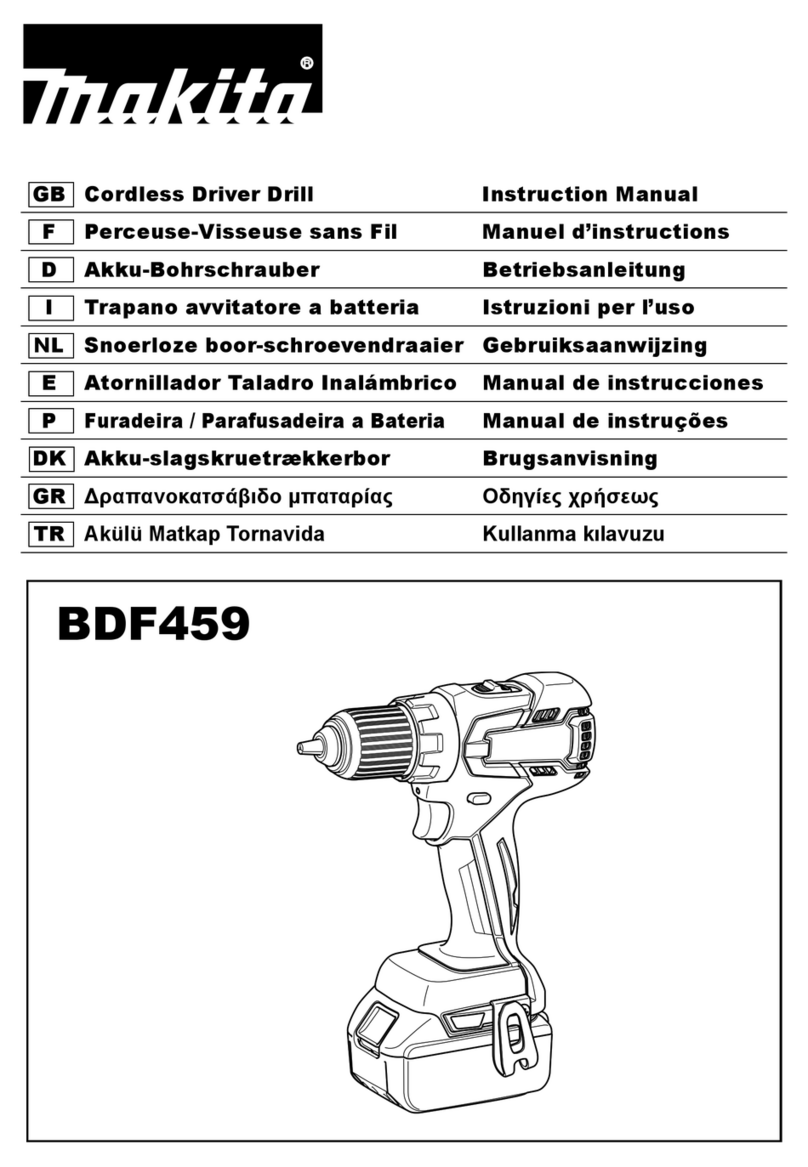
Makita
Makita BDF459 instruction manual

Cornwell Tools
Cornwell Tools CAT-250HD operating instructions

BASETech
BASETech 1429465 Original operating instructions
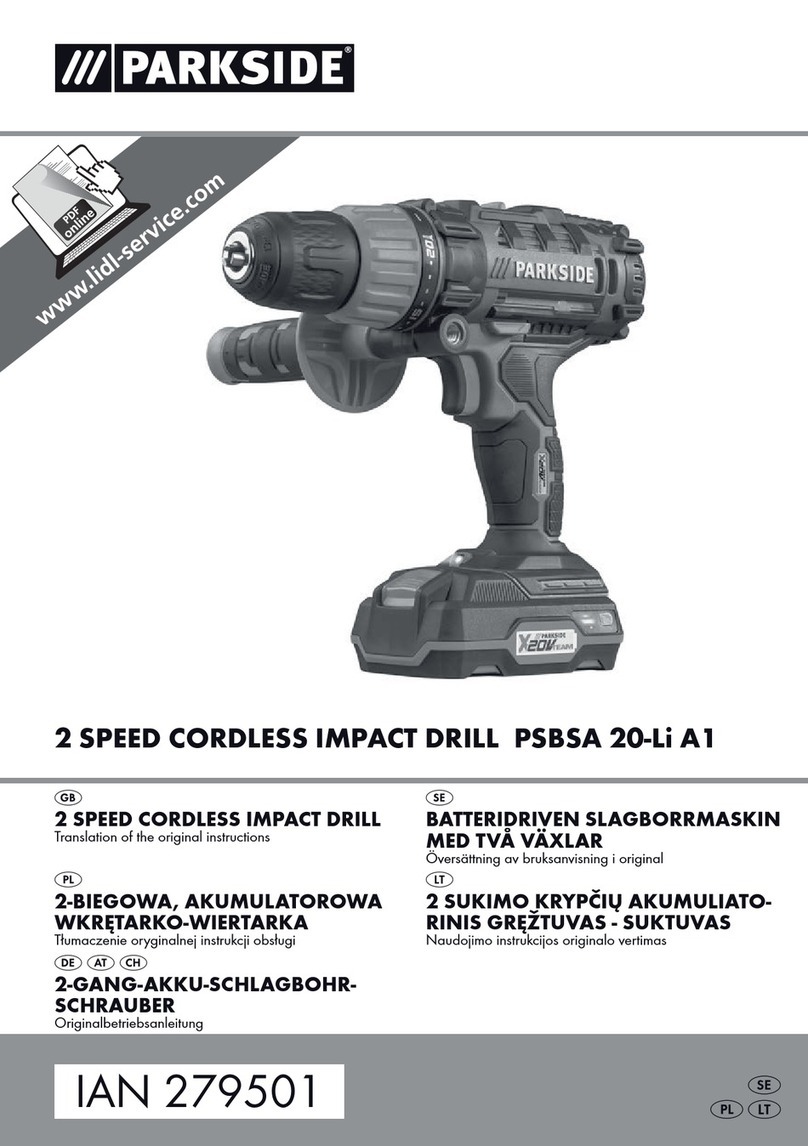
Parkside
Parkside PSBSA 20-Li A1 Translation of the original instructions

Makita
Makita BHP440 instruction manual

BONASTRE
BONASTRE Magic Renova manual

Sparky Group
Sparky Group HD Professional BR2 18Li HD Original instructions

Unitor
Unitor AD-PRO 1800 instruction manual

Makita
Makita DDF480 instruction manual
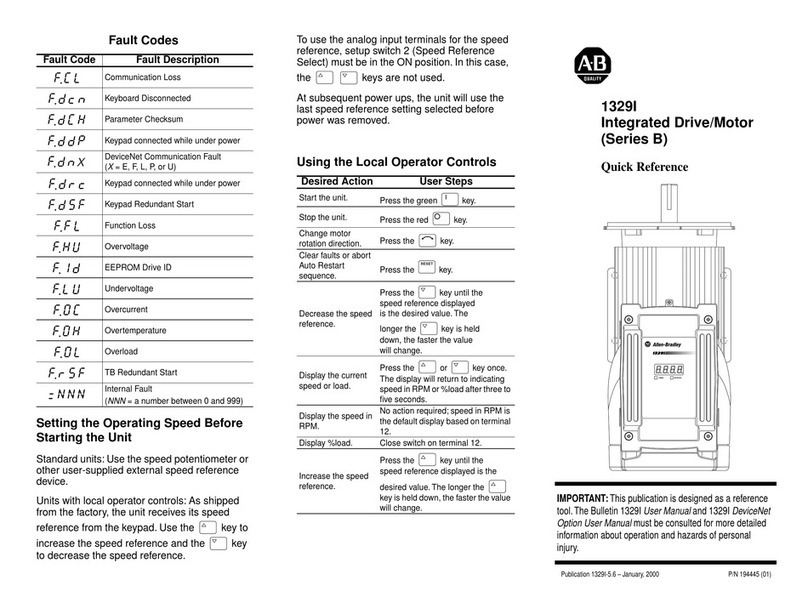
Allen-Bradley
Allen-Bradley Series B quick reference

EINHELL
EINHELL TE-ID 750/1 E Original operating instructions

Clarke
Clarke CHD850B Operation & maintenance instructions
